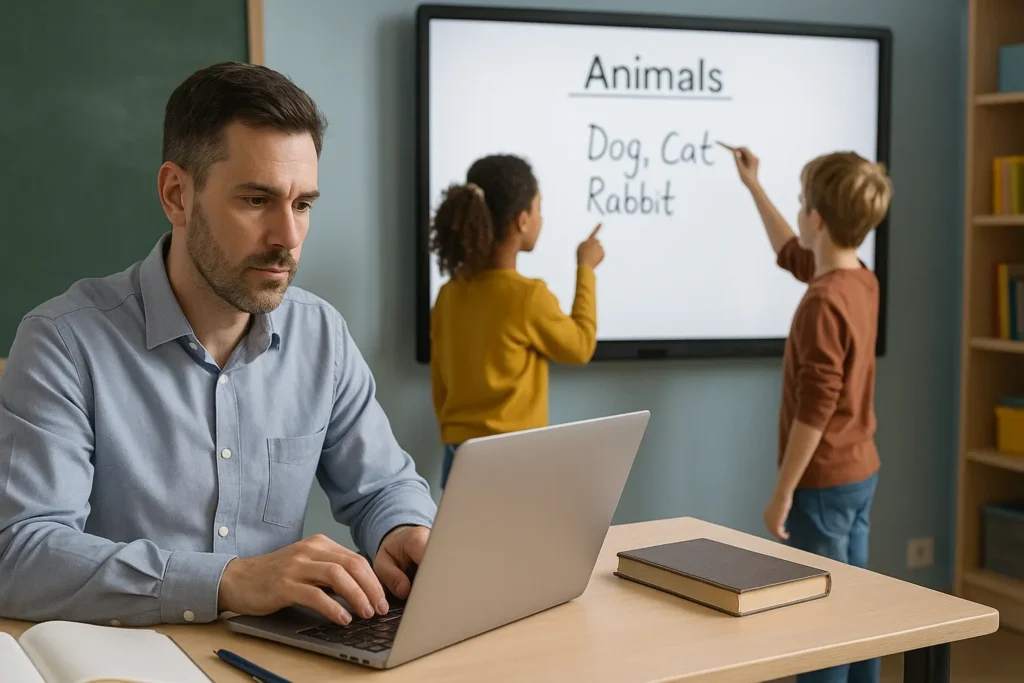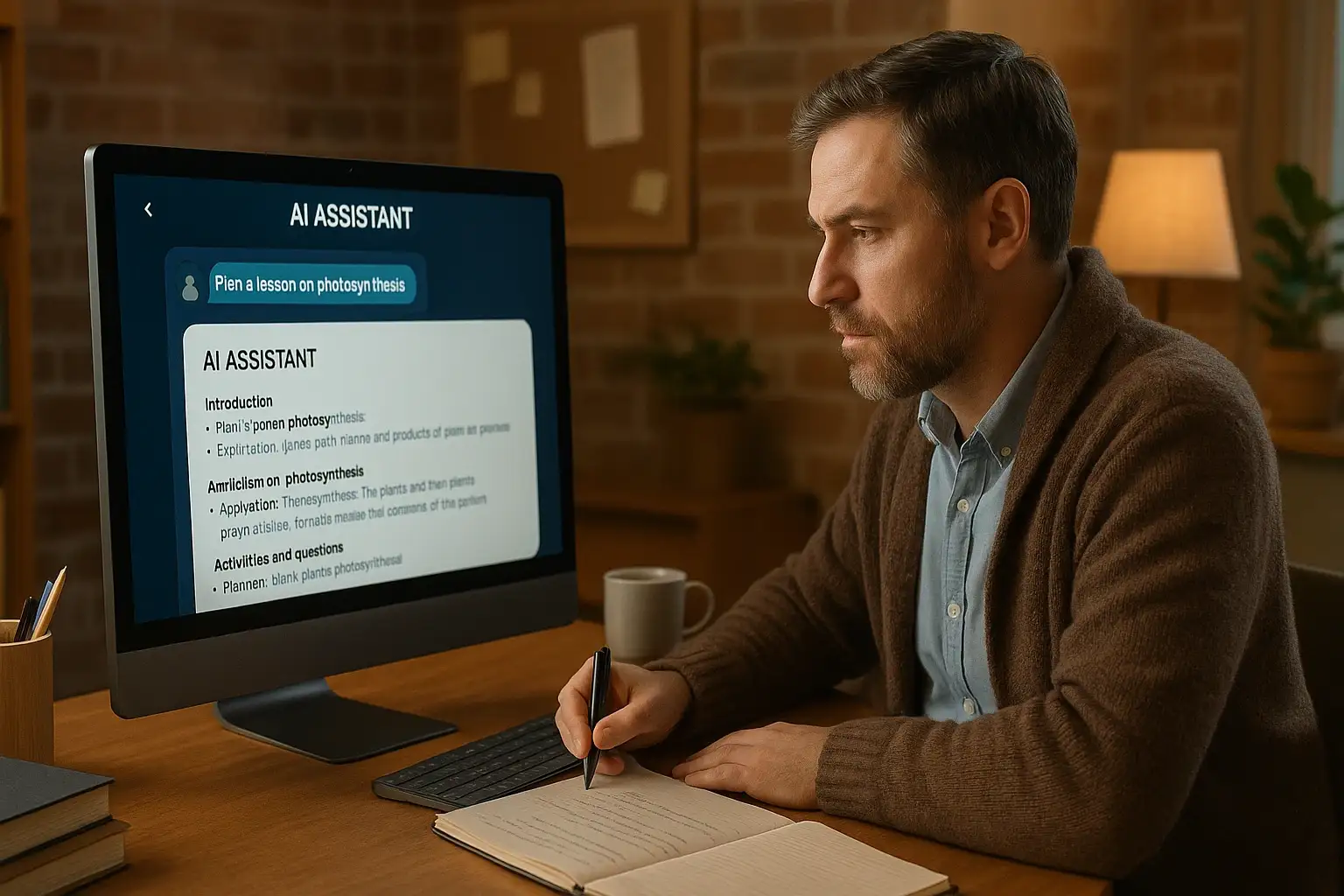How teachers are adapting to AI in education is a topic that’s on the minds of many educators today. You’ve probably heard a lot about Artificial Intelligence (AI), and maybe even felt a little unsure about what it means for your work in the classroom. Is it going to replace teachers? Is it too complicated to use? These are real questions, and you’re not alone in asking them.
The good news is that AI can actually bring more balance to your routine, helping you focus on what truly matters — connecting with your students. With the right guidance, teachers from all backgrounds can start using AI in ways that feel natural, empowering, and rewarding.
Why AI Is Entering the Classroom
Let’s start with a simple thought: AI is like a helper that can save time and give ideas. Imagine having a tool that corrects essays, creates quizzes, or helps you understand which student needs extra help. Sounds great, right?
This shift is part of a bigger transformation in education, where technology is used not to replace the teacher but to amplify their abilities. AI supports teachers just like calculators once did for math or projectors for visual learning — it’s another evolution in teaching tools.
How Teachers Are Adapting to AI in Education
Embracing Change Step by Step
Many teachers are taking small, easy steps to start using AI. You don’t need to be a tech expert or change everything overnight. Some are beginning with simple tools like:
- ChatGPT: Used to generate ideas for lessons, emails to parents, or class activities.
- Google Classroom with AI integrations: Helps organize work and gives feedback faster.
- Khan Academy’s AI tutor: Assists students with tailored guidance (https://www.khanacademy.org).
Starting small allows teachers to build confidence at their own pace. By exploring AI one feature at a time, educators often discover creative ways to enhance their teaching style without feeling overwhelmed or pressured to master everything at once.
Using AI for Lesson Planning
Teachers often spend hours preparing classes. AI can save time by helping to:
- Create summaries of texts.
- Suggest interactive activities.
- Adapt materials to different student levels.
This also opens doors for more dynamic lessons. With AI suggesting fresh formats and approaches, teachers can diversify their teaching strategies, making the classroom experience richer for students with different learning styles.
Personalizing Learning
Every student learns at their own pace. AI can analyze students’ progress and suggest what they need to review or move forward with. This means:
- Students don’t get left behind.
- Fast learners stay challenged.
- You get clear insights on who needs extra help.
In classrooms with a wide range of abilities, AI acts as a bridge that connects learners to exactly what they need, giving teachers the support to ensure no one is left out or held back unnecessarily.
👉 Explore whether AI can replace traditional teaching in education and how it can complement classroom teaching to enhance learning.
Benefits Teachers Are Experiencing
Saving Time
Grading, planning, emails — AI can help handle many of these, giving you more time for what matters: connecting with students.
This extra time gives teachers room to breathe, reflect, and even innovate. When you’re not buried under repetitive tasks, you can invest energy into more meaningful activities like one-on-one support or creative projects.
More Engagement in the Classroom
Interactive AI tools like quiz generators or educational games are making classes more fun. When students are engaged, they learn better.
These tools often offer instant feedback, which keeps students motivated and focused. Instead of passively listening, they become active participants in their learning process — which often leads to better results.
More Confidence in Teaching
With AI, many teachers feel more supported. It’s like having a teammate who never gets tired and is always ready to help.
Confidence also grows because AI gives instant access to suggestions, explanations, and content examples. Teachers no longer have to search endlessly for resources — help is just a click away.
Challenges Teachers Face with AI
Learning to Use New Tools
Some tools may seem hard at first, especially if you’re not used to technology. But with practice — and a little curiosity — it gets easier.
Moreover, many platforms are now designed to be user-friendly, offering tutorials, guides, and even customer support tailored for educators. The learning curve is smoother than many imagine.

Lack of Training and Support
Not all schools offer training. That’s why many teachers are learning through YouTube tutorials, free webinars, or even asking colleagues for help.
However, some organizations and universities are starting to offer AI-focused professional development for educators. Staying updated on these opportunities can make all the difference.
Fear of Replacing the Human Touch
This is a big one. Some worry that machines will do all the work. But AI can’t replace your care, creativity, or classroom presence. Students still need your guidance, your attention, and your encouragement.
The human element in teaching — your intuition, your empathy, your connection — is what builds trust and inspires growth. AI can’t replicate that, and it never will.
How to Start Using AI as a Teacher
Here are simple steps to begin:
- Pick one task that takes time (like grading or planning).
- Choose a simple AI tool (like ChatGPT, Canva Magic Write, or Quizizz).
- Try one small use — write a quiz, explain a topic, or summarize a lesson.
- Ask for help — Join teacher groups online and watch tutorials to get help.
- Reflect and grow — what worked? What can you try next?
Even a 10-minute experiment each week can grow your skills and comfort with AI. Over time, these small moments build into meaningful changes in how you teach and how your students learn.
Key Points About How Teachers Are Adapting to AI in Education
- AI helps teachers save time with tasks like grading and planning.
- Tools like ChatGPT and Socrative are already making a difference in classrooms.
- Personalizing learning is easier with AI suggestions.
- Teachers are starting small and gaining confidence with practice.
- The human role in education is still essential and irreplaceable.
Conclusion
Artificial Intelligence is not a distant concept or something only for tech experts. It’s already part of many teachers’ daily routines — helping with planning, saving time, and improving learning.
As you explore and grow with AI, remember that you don’t have to do it alone. There are communities of educators sharing tips and tools, and together we can shape a future where technology lifts us, not limits us.
Have you tried any AI tool in your classroom? Share your experience in the comments below — your story can inspire others!

